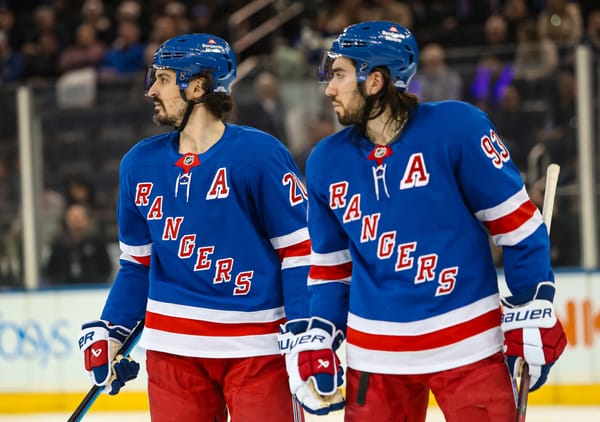2014 Report Card: Derick Brassard finds a fit on the third line
Forced into a top-six role early in the season, Derick Brassard found a place on the Rangers third line, where he excelled.
With the offseason underway, it's officially time to start reviewing the 2013-2014 season. Our goal is to bring you one player review every day until we're out of Rangers to talk about. So, let's kick things off, and get the conversation started.
In his first full season as a New York Rangers, Derick Brassard found a home in between Mats Zuccarello and Benoit Pouliot. The third line center, who also played on the Rangers second power play unit, finished fourth on the Rangers in points (45) and goals (18), and fifth in assists (27). Here's more on Brassard's season.
Rough Beginnings
Like virtually the entire Rangers team, Brassard stumbled out of the gate. Failing to score a goal in his first eight games, Brassard finally got off the snide scoring the overtime winner against the Red Wings October 26. One of the major problems Brassard faced in the early goings was with the rash of injured Rangers forwards, he was asked to play a top-six role. Formerly the number six overall pick in the 2006 Draft, Brassard certainly had top-tier expectations coming into the league, but is certainly more equipped to be playing on a third line. So when the Rangers finally got healthy, and Alain Vigneault plugged him in between Zuccarello and Pouliot, his season really took off.
As did the Rangers'. New York was already beginning to come out of its funk in the weeks before Vigneault grouped those three players together, but after he did so, Brassard's production saw an increase. It all began January 4 when the Rangers thumped the Maple Leafs 7-1. In his 40 games played beginning with that Toronto game, Brassard posted 11 goals compared to the seven he scored in his first 41 games. His line was able to drive possession, and Brassard was a big part of that. With his vision, passing ability, and peskiness with the stick, Brassard was great in the offensive zone simply keeping plays alive, and opening things up for the Blueshirts.
Where Brassard really excelled was on the power play. As the Rangers improved under new assistant coach Scott Arniel (who, coincidentally, after coming over from Columbus in the offseason, had to make amends with Brassard, his former Blue Jackets pupil), Brassard was a big contributor, netting a team-high seven goals. While the first group had the Rangers' big names, it was the puck movement of that second unit that really opened things up. Brassard was effective from position off the half-wall, and made a living rotating to the high-slot, where his shot, which coaches encouraged him to use more, was able to get through.
What it most likely comes down to with Brassard is once he found an appropriate role, his comfort level and game took big steps. There's nothing wrong with playing on the third line, especially when it turns something like depth into a strength. And if that's where Brassard can make his biggest impact—on the bottom six and the second power play unit—then what not a better place for him to slot in?
Playoff Performer
With goals needing to come from somewhere, Brassard stepped up in the postseason to the tune of six tallies, the third-most of any Ranger. But four of those goals came in the Rangers first 13 of the postseason, including two game-winners. Brassard went down in Game 1 of the Montreal series with an apparent shoulder injury, before returning in Game 4 and scoring a clutch, late-period goal. Overall, he was one of the more dangerous Ranger forwards in the playoffs, as his line didn't skip a beat when the regular season ended. Brassard looked steady when he returned, as evidenced by the quick goal, but he certainly lost some momentum having to sit out a few games.
Contract Status
Brassard is a restricted free agent, and is coming off a four-year deal that paid him a little over $3 million per. Regardless of how many years he gets on a new deal, he'll likely be making roughly the same number when he signs. Moreover, retaining that entire third line and building on the chemistry it created this season could go along way for the Rangers if the team is to make other offseason changes.




